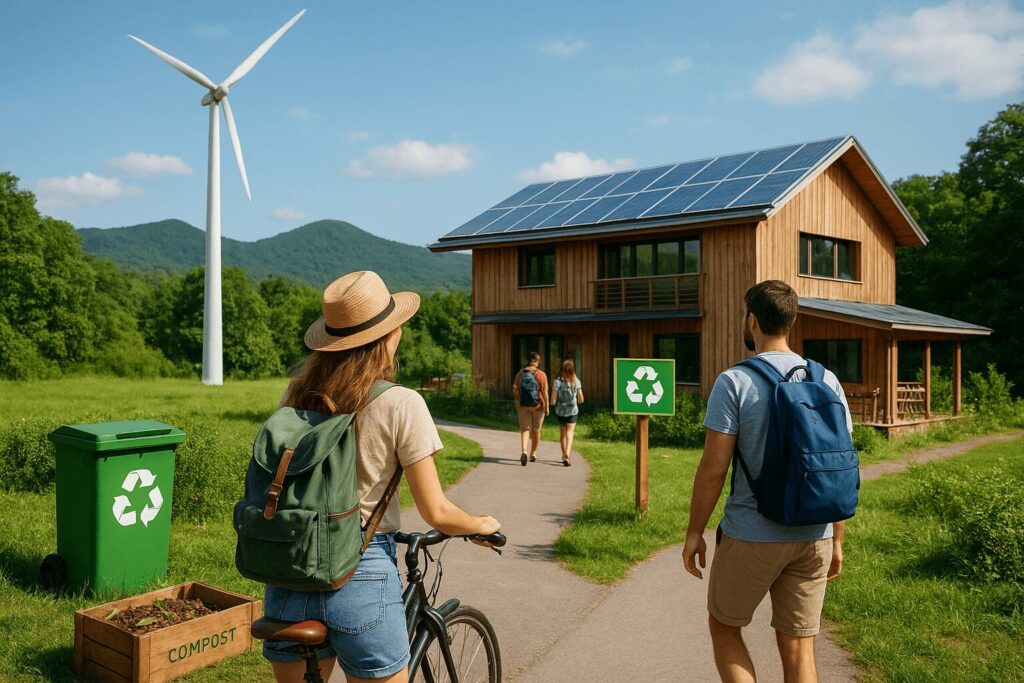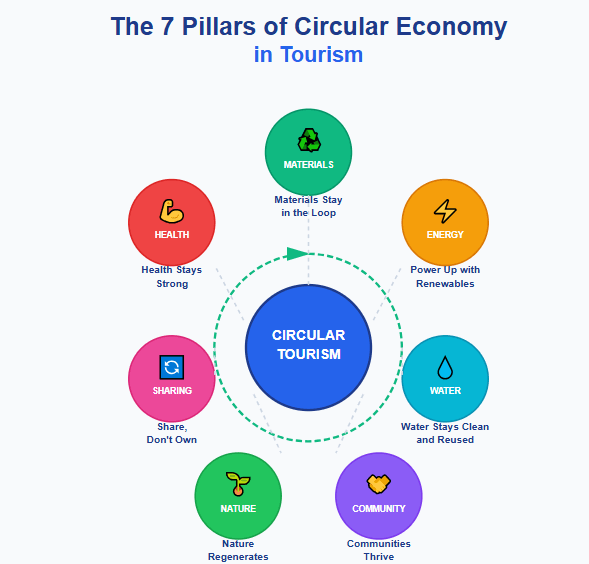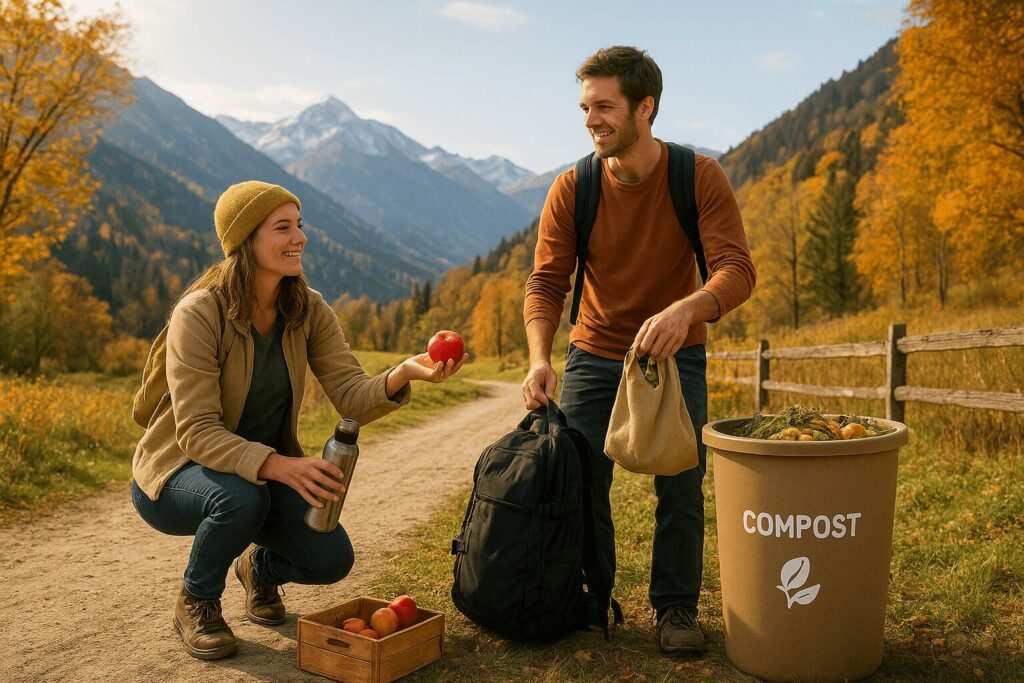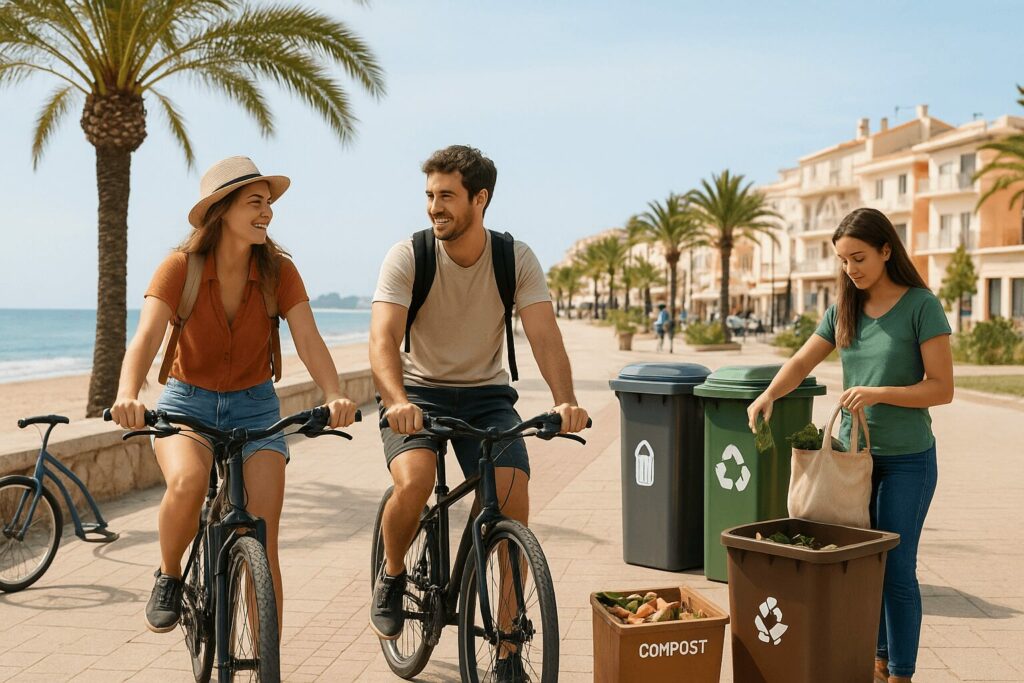
Circular Economy in Tourism: Cases for Sustainable Travel
Seeking for circular economy in tourism examples? or wondering if your dream vacation could leave a lighter footprint? 🌍 Traditional tourism’s “take-make-dispose” cycle is trashing our planet, with 8% of global emissions and counting! 🚨 Experts warn unchecked growth could spike energy 154% by 2050 – yikes! That’s where circular economy tourism steps in, flipping the script, with zero-waste hotels or sharing platforms like Peerby, letting travelers borrow gear instead of buying new. We’ll unpack the 7 pillars transforming waste, from renewable energy to community-driven experiences. Spoiler: Your next trip could be greener, more local, and packed with authentic vibes. As for professionals, you’ll find out where sustainability in hospitality challenges and opportunities are when you consider circular economy in your operations. Let’s dive in! ✈️✨
Article Takeaways
The circular economy is transforming tourism from a wasteful « take-make-dispose » model into a regenerative system that treats waste as a resource. Currently responsible for 8% of global emissions, the tourism sector is adopting seven key pillars: material reuse, renewable energy, water conservation, community empowerment, nature regeneration, sharing platforms, and health preservation. Hotels are slashing energy consumption by up to 65% through solar power and waste-to-biogas systems, while apps like Too Good To Go tackle the industry’s 35 million tonnes of annual solid waste. With 83% of travelers prioritizing sustainability, circular tourism creates a triple win: reduced environmental impact, strengthened local economies, and authentic travel experiences that benefit both destinations and visitors. Need more details? Keep reading this Circular Economy in Tourism Examples !
Table of Content
- So, what’s the deal with circular economy in tourism? 🤔
- The 7 pillars: your guide to circular travel
- Linear vs circular tourism: a total game-changer
- Circular stays: How hotels are getting smarter and greener 🏨
- From trash to treasure: tackling food and waste on your travels 🍽️
- Getting around and diving in: circular mobility and authentic vibes 🚲
- It’s not all smooth sailing: the challenges and how you can help 💪
- Ready to join the circle? The future of travel is here ✨
So, what’s the deal with circular economy in tourism? 🤔
Alright, let’s talk about travel. We all love exploring new places, right? But here’s the catch: traditional tourism follows a take-make-dispose model that’s wreaking havoc on the planet 🌍. Think about it – hotels, planes, and tourist activities guzzle resources and generate massive waste. According to analyses of the sector, this linear approach is shockingly unsustainable. The tourism industry alone pumps out 8% of global greenhouse gases, and if we keep going like this, energy consumption could skyrocket by 154% by 2050. Yikes!
But here’s the good news: there’s a smarter way. Enter the circular economy in tourism – a game-changer that turns waste into resources and turns trips into positive impacts 🔄. Imagine vacations where hotels reuse materials, transportation runs on renewable energy, and local communities actually benefit from tourism dollars. It’s not a fantasy – it’s happening now! Think of it as travel that gives back as much as it takes.
Why does this matter? Well, the environmental impact of current practices is staggering. Every dollar generated by tourism creates 1.02kg of carbon emissions – four times more than the services sector! The good news? Companies like Studiosus, a certified EMAS travel agency, are leading the way by prioritizing train travel over short flights and investing in renewable energy projects.
Ready to dive deeper? Let’s unpack how sustainable tourism is rewriting the rules – from zero-waste hotels to bike-sharing schemes. Spoiler alert: the future of travel might look nothing like the past. You won’t want to miss this! 🚀

The 7 pillars: your guide to circular travel
Let’s decode the 7 pillars of circular economy 🌍—your toolkit for eco-smart adventures. These aren’t fluff—they’re real solutions cutting waste while boosting local economies. Ready to explore without trashing the planet? 🌟
- ♻️ Materials stay in the loop Think hotel shampoo bottles reborn as new bottles, not trash. Resorts reuse construction materials, axe single-use plastics, and pick compostable options. E.g., Soneva Fushi turns waste glass into art. Keep resources in the loop. ♻️
- ⚡ Power up with renewables Picture solar cabins in Costa Rica or KLM’s biofuel flights. Renewable energy slashes emissions and bills—eco-lodges run on hydro, wind, or solar. Cochin Airport is 100% solar. Sun = win! ☀️
- 💧 Water stays clean and reused Clean H₂O is sacred. Amsterdam parks refill fountains with rainwater, while Maldives resorts treat wastewater for gardens. Some use greywater systems for irrigation. 🚰
- 🤝 Communities thrive Local guides in Morocco or Bali’s homestays? That’s this pillar. Fair wages, cultural preservation, and shared profits make tourism work for locals. E.g., Fairbnb channels half profits into local projects. 🤝
- 🌱 Nature regenerates Rwanda’s gorilla treks fund reforestation. EasyJet plants trees to offset flights. E.g., Paris’s Olympic Village reuses materials. Nature’s a partner, not a resource. 🌱
- 🔄 Share, don’t own Rent bikes or use Fairbnb? That’s circular. Airlines share maintenance gear, travelers swap stuff online. E.g., Nannybag lets travelers store luggage locally, slashing airport waste. 🚲
- 💆 Health stays strong Car-free zones in Venice mean fresher air. Farm-to-table meals ditch toxins. Circular travel = clean, happy vibes. 🧘
These pillars work together. Aligned with SDGs like climate action, circular tourism flips the script. Ready to make your next trip a force for good? ♻️
Linear vs circular tourism: a total game-changer
| Aspect | Linear Tourism (The Old Way) | Circular Tourism (The Smart Way) |
|---|---|---|
| Resources | Take, use, dispose (e.g., single-use plastic bottles) | Use renewable, reuse, recycle (e.g., refillable water stations) |
| Waste | Sent to landfill, creates pollution | Minimized, seen as a resource (e.g., food scraps become compost) |
| Energy | Fossil fuels, high consumption | Renewable energy (solar, wind) |
| Local Community | Often excluded or negatively impacted | Integrated, benefits shared, local culture valued |
| Tourist Experience | Standardized, consumptive | Authentic, engaging, educational |
Alright, let’s break it down 🧩. Linear tourism? It’s the « take-make-waste » model we’ve relied on for ages. Think plastic bottles littering beaches or food scraps rotting in landfills. But circular tourism flips the script by turning waste into a resource and prioritizing authentic experiences that locals and travelers both enjoy.
Check out the table above – it’s not just about saving the planet 🌍. Circular models create resilient tourism by reducing costs (hello, renewable energy!), boosting community ties, and making trips more memorable. When hotels reuse materials or restaurants donate leftovers via apps like Too Good To Go, they’re not just being eco-friendly – they’re future-proofing the industry. Think of it as upgrading from a flip phone to 5G 🚀.
Circular stays: How hotels are getting smarter and greener 🏨
Ever wondered what happens to that tiny soap bar you leave behind in a hotel? Spoiler: it’s probably ending up in a landfill. But guess what? Hotels are flipping the script, turning waste into wonder while slashing their environmental footprint. Let’s dive in.
Hotels gobble up resources like no one’s business. But here’s the kicker: they’re also perfect labs for circular economy magic. Simple swaps? Think refillable shampoo dispensers instead of single-use mini bottles. Or cloth towels over paper wipes. Small change? Maybe. But when scaled, it adds up!
Take the Crowne Plaza Copenhagen. This eco-warrior hotel cuts energy use by 65% compared to peers. How? Solar panels cover their roof, and a groundwater system chills rooms in summer and warms them in winter. Even food scraps get a second life—turned into biogas and fertilizer. Zero waste? More like zero waste of opportunity.
Renewable energy isn’t just a buzzword here. Imagine walls soaked in solar power or geothermal heating. Hotels are tapping into Mother Nature’s freebies—wind, sun, and underground water—to slash emissions. And it’s not just high-tech: even the basics, like encouraging guests to reuse towels, make a dent. Think of it as “slow living” meets hospitality.
Now, check the Balearic Islands, where laws now force hotels to draft circular economy plans. RIU Hotels? They’re leading the charge. Their certified eco-hotels convert food waste into compost for local farms and recycle glass into art. Why? Because “waste” is just a resource in disguise.
Hotels like these prove circular stays aren’t a dream. They’re a reality where every soap sliver, every food scrap, and every lightbulb matters. Ready to book your next stay with a side of sustainability? 🌍

From trash to treasure: tackling food and waste on your travels 🍽️
Let’s face it: tourism leaves a trail of plastic footprints and food waste. Did you know? The sector generates 35 million tonnes of solid waste yearly, with tourists in Tunisia producing 2.6kg of waste daily—triple locals’ output. Yikes! 🌍 But here’s the good news: circular economy principles are flipping this script. Let’s dive into how.
First, tackling food waste. Apps like Too Good To Go let hotels sell surplus food at discount prices—snagging a luxury breakfast for half the cost? Win for your wallet and the planet. Some hotels even compost organic scraps into garden gold, turning banana peels into nutrient-rich soil. ♻️
What about zero waste goals? Over 60 organizations, including major hotel chains, joined the Global Tourism Plastics Initiative, pledging to slash single-use plastics by 2025. Think refillable shampoo bottles or bamboo straws—small changes, big impact. Some resorts compost waste into soil for local farms, closing the loop. 🌱
- Donating leftover food: Partnering with apps like Too Good To Go to redirect tons of food waste annually.
- Effective recycling: Collaborating with waste management and guiding tourists—FairBnb’s zero-waste guest guides are a solid example.
- Composting organic waste: Turning scraps into compost for gardens, like eco-resorts in the Caribbean repurposing food waste into local agriculture.
- Eliminating single-use plastics: Following frameworks like the Global Tourism Plastics Initiative to ditch unnecessary plastics—reducing seaside waste by 45%.
These efforts aren’t just eco-buzzwords—they’re game-changers. Transforming waste into resources lets hotels cut costs, cut pollution, and craft quirky menu items from surplus ingredients. Some hotels use compost to grow veggies, turning waste into fresh ingredients—proving sustainability tastes great. Now that’s what I call turning trash into treasure. 🌟
Getting around and diving in: circular mobility and authentic vibes 🚲
Tourism causes 8% of global CO₂ emissions, with 75% from transport—planes, cars, and cruises being the worst offenders. The fix? Circular economy principles, obviously! Let’s dive into how.
Dump the rental car and grab an e-bike! Hotels teaming up with Véloc’Ouest offer French-made Arcade e-bikes (50 km autonomy) for eco-friendly exploration. Example: La Rochelle’s bike-friendly paths let you tour salt marshes or vineyards guilt-free. 🌍
Try sharing platforms like Peerby. Borrow unused gear—tents, snorkels, or even camping stoves—from locals. Did you know 80% of owned items sit idle? Less stuff = lighter luggage = less fuel burned. Win for your wallet and the planet!
Craving authentic experiences? Skip chain hotels. Couchsurf in a Parisian’s apartment or book a treehouse via France Vélo Tourisme. Hosts share hidden gems—like a family-run vineyard in Bordeaux—boosting their economy while you sip local wines. 🚴♂️
Lean into local resources. Savor farm-to-table meals (10 km max transport) or craft souvenirs from upcycled seashells with Mediterranean artisans. Less shipping = more sharing. Picnicked on a HomeCamper host’s lawn? It beats crowded buffets. 🍷
Ready to travel lighter? Peerby’s sharing model, bike-friendly stays, and community-driven trips prove green adventures = epic memories. 🌱

It’s not all smooth sailing: the challenges and how you can help 💪
Alright, let’s talk turkey. Switching to a circular economy in tourism sounds amazing, but it’s not all sunshine and rainbows. Yep, there are real challenges holding things back. High upfront costs for sustainable upgrades? That’s a biggie. Hotels and tour operators might balk at spending €50k on solar panels or water-saving tech. Then there’s the “but we’ve always done it this way” mindset. Both businesses and tourists sometimes cling to old habits—like tossing plastic straws or ignoring local recycling rules. And let’s not forget spotty government support. Some places still subsidize fossil fuels while green initiatives fight for crumbs in budgets.
But hey, you’re not just a bystander! Your responsible choices as a tourist pack serious punch. Did you know 83% of travelers today say sustainable travel matters? Yet 67% struggle finding options that aren’t just greenwashing fluff. That’s where your power kicks in.
- Choose wisely: Hunt for accommodations and tour companies with clear eco-certifications like Green Key or Biosphere. Booking.com now tags 45% of listings with sustainability badges!
- Pack smart: Ditch single-use plastics. Toss a collapsible water bottle and bamboo utensils in your bag. That tiny €10 investment cuts 200g of plastic waste/year per traveler.
- Go local: Skip chain restaurants. Hit up Maria’s family-run trattoria—your €20 meal funds 3x more local jobs than a tourist trap.
- Waste less: Reuse those hotel towels! It slashes water use by 17% per guest stay. And when hotels tout “reuse programs,” actually participate—only 34% of guests do.
- Speak up: Loved that zero-waste shampoo bar at your hotel? Tweet about it! Positive feedback makes companies 4x more likely to expand green initiatives.
Think of it as vote-with-your-wallet 2.0. Every consumer demand you create nudges the industry toward circular practices. Remember: when 71% of travelers say they want destinations better off after their visit, your your role as a tourist becomes a catalyst. So next time you book, ask: “Does this experience close the loop or just cash the check?” The planet’s counting on your next trip to be a game-changer.
Ready to join the circle? The future of travel is here ✨
Alright, let’s wrap this up: the circular economy isn’t just a buzzword—it’s a total game-changer for tourism. Imagine a world where your vacation leaves zero waste, boosts local communities, and still lets you have epic experiences. That’s the triple win we’re talking about! 🌍
Sure, the pandemic hit tourism hard, but it also gave us a chance to rebuild better. Think of it as a reset button. Destinations are now embracing circular principles—from zero-waste resorts to bike-sharing hubs. Guess what? This isn’t just good for the planet; it’s creating jobs, preserving cultures, and giving travelers like you deeper, more meaningful adventures. A new framework for sustainable recovery proves this shift is backed by real action.
So, next time you plan a trip, ask: “How can I make conscious choices?” Rent a bike instead of a car. Stay in a solar-powered hostel. Support local food systems. Small steps, huge impact! The future of travel is in our hands. Let’s keep it wild, inclusive, and circular. 🌱✈️
The circular economy isn’t a buzzword—it’s tourism’s game-changer. Closing loops and boosting communities make travel a positive force. With 83% of tourists craving sustainability, your eco-choices—reusable bottles, eco-certified stays—drive change. Future trips: smarter adventures without sacrificing comfort. Ride this wave—start now. 🌍✨
Q / A About Circular Economy in Tourism Examples
What are the 4 R’s (or 5 R’s) of circular economy? 🧮
Alright, let’s clear this up! While the 5 R’s are more common, here’s the breakdown: Refuse (avoid what you don’t need), Reduce (use less), Reuse (give items a second life), Repair (fix what’s broken), and Recycle (reprocess materials). Some frameworks add a sixth R: Recover (extract value from waste). Got it? It’s like a checklist to keep resources in the game longer!
What are the 5 types of sustainability in tourism? 🌿
Let’s break it down! The five pillars are: 1. Environmental (protecting ecosystems), 2. Socio-cultural (respecting local traditions), 3. Economic (supporting local businesses), 4. Cultural (preserving heritage), and 5. Political (fair policies). Together, they’re a delicate balancing act to make tourism work for people, planet, and profits—no shortcuts!
What circular challenges hit tourism development? 🤔
Great question! Key issues include overconsumption of resources (like water in hotels), single-use plastics (hello, tiny toiletries!), and seasonal over-tourism that strains local infrastructure. Plus, getting everyone—businesses, tourists, governments—on the same page? Tricky! But solutions like refill stations, composting, and community-led tourism can turn these headaches into wins. It’s a journey, not a sprint! 🌍
What are the 7 pillars of circular economy? 🧭
The 7 pillars? Let’s roll them out! 1. Cycle materials at their highest value 🔄, 2. Use 100% renewable energy 🌞, 3. Protect water quality 💧, 4. Boost human/social capital 👥, 5. Regenerate natural systems 🌱, 6. Share resources/services 🚗, 7. Prioritize health + wellbeing 🏥. These pillars are your roadmap to a greener economy—no jargon, just action!
What’s the 10 R’s framework? ♻️
The 10 R’s? It’s an upgraded playbook! Beyond the basics, it adds: 6. Refurbish, 7. Remanufacture, 8. Repurpose, 9. Recycle (advanced), 10. Recover energy. Think of it as turbocharging resource efficiency—turning “trash” into treasure at every step. Fancy a circular glow-up? This is your cheat sheet!
What’s the 9R strategy? 🔁
The 9R strategy? Let’s crack it open! It’s a beefed-up version of the 5 R’s: 1. Refuse, 2. Reduce, 3. Reuse, 4. Repair, 5. Refurbish, 6. Remanufacture, 7. Repurpose, 8. Recycle, 9. Recover. It’s like a step-by-step guide to squeeze every last drop of value from resources. Fancy saving the planet one loop at a time? This is your jam!
